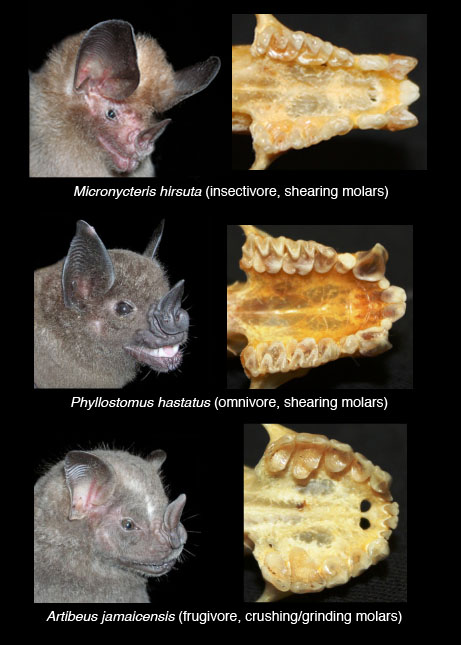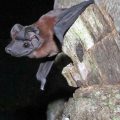In a clever use of GPS technology, biologists at the University of Massachusetts Amherst have “mapped” the topography of bat teeth as if they were uncharted mountain ranges, in order to better understand how toothy ridges, peaks and valleys have evolved to allow different species to eat everything from hard-shelled insects to blood and nectar.

The faces and upper teeth of bats that eat insects (top), fruit (bottom) and a combination of fruit and insects (middle). (Image credit: Sharlene Santana)
Using a method based on geographic positioning systems that allows them to characterize the topography of the bats’ molars in a way similar to how geographers characterize mountain surfaces, the researchers calculated a measure of dental complexity that reflects how “rugged” the surface of the tooth is. Their work was supported in part through a predoctoral fellowship from the Smithsonian Tropical Research Institute.
Working with field-collected bat skulls, researchers Sharlene Santana and Betsy Dumont of the University of Massachusetts, with Suzanne Strait of Marshall University, compared the structure of molars across 17 species of the New World leaf-nosed bats that specialize in a variety of different diets (insects, fruits, and a combination).
They found that the molars of fruit-eating species had sharp outer edges that likely allow them to pierce tough fruit skin and pulp, plus large surfaces with tiny indentations that may help them grind fruit pulp efficiently. By contrast, the molars of insect-eating species were less complex, possibly because of their smoother shearing surfaces. The more simply-shaped teeth would presumably be good for cutting through hard insect exoskeleton. A paper on their research was published in the journal Functional Ecology.
Video: Three views of bat teeth in species specialized for different diets. First, fruit eaters have broad chewing teeth with many tiny bumps (Artibeus jamaicensis), while the second set of teeth, in an insect eater, show more ridges (Micronycteris hirsuta). Finally, teeth of a species that eats both fruit and insects have the tallest and simplest chewing tools(Phyllostomus hastatus). Video courtesy www.biomesh.org.
The researchers further tested if, within insect-eating species, higher molar complexity was related to a greater ability to crush insect prey. They fed beetles to field-caught bats, recorded their feeding behavior, then collected fecal samples to measure how well the beetles had been broken down. “We found that insect-eating bats with more complex molars were better at breaking down prey, but how much bats chewed their prey was also important,” Santana and colleagues say.
“Our study highlights the functional significance of tooth structure and chewing behavior in breaking down natural prey and…..provides a major step forward in understanding mammalian feeding systems,” the researchers say. —Janet Lathrop, University of Massachusetts





